What is an IP Assignment Agreement?
An Assignment Agreement transfers rights, title, and interest in a patent and associated IP. This agreement is a legal document that is entered into between two parties: the Assignor of the IP from whom the IP is transferred from), and the Assignee who "receives" the IP rights. These IP rights include trademarks, copyrights, patents, and trade secrets. If well drafted, it ensures clarity, transparency, and legal enforceability in the transfer of rights between the Assignor and the Assignee.
How can IP Assignment Agreements help your startup?
Startup IP protection is crucial to the success of your startup in three key ways.
1. It ensures that your startup has the right to use a certain IP (and its respective rights) in certain ways
For example, your startup may have made an agreement with a third party individual or firm to develop a certain product or design for your startup. Here, you would need an Assignment Agreement to clearly transfer the IP rights from the third party to your startup. If the IP rights are not successfully transferred to the extent to which your startup requires it, the third party may have grounds to commence legal action against your startup for IP infringement. For example, your startup may have only purchased a licence to use the IP rights for a duration of one year (as opposed to full ownership of the IP) without the rights to make modifications to the IP. But in fact, your startup has made modifications to the IP and have continued using it past one year—even incorporating it into the design of your flagship product. This would severely harm your startup, which would incur time and costs in handling the dispute (or worse - taking it to court), and even hamper your ability to sell your flagship product.
2. A well drafted IP Assignment Agreement prevents internal disputes between individual employees of the startup and the startup company itself.
Without a clear agreement passing the IP rights to the startup, it may be unclear whether it is the startup itself or individual founders, employees (such as those employed as engineers or artists), or other parties within the company who are the true owners of the IP. This may lead to legal disputes down the line, for example, where the employee leaves and wants to use their IP in their new job or demands that your startup cease using their work. Other documents, such as a product development NDA, could also help your startup maintain control over its IP.
3. Ambiguities about IP ownership and rights may deter potential investors
When potential investors conduct due diligence, they will also check for the ownership of IP used by the startup. If they do not have confirmation that it is the startup itself who owns the IP, they may decide that the investment is too risky for the same reasons that legal disputes may arise above. Therefore, it is important to draft and make clear agreements transferring the IP rights to protect startup ideas in order to minimize the potential liabilities which potential investors would account for.
How to draft an IP Assignment Agreement for the full transfer of IP rights
Introduction
The document begins with a brief introduction, stating the names and principal places of business of both parties. It then proceeds to outline the background and purpose of the agreement.
Definitions and Interpretations section
This provides definitions for key terms used throughout the agreement. This section ensures clarity and consistency in the interpretation of the document.
Assignment section
Here, the Assignor (i.e. the creator of the IP) irrevocably and absolutely assigns its rights, title, and interests in the patent and assigned IP to the Assignee (i.e. your startup). This section ensures a clear transfer of ownership from the Assignor to the Assignee.
“Moral rights” are the rights that belong to the original author of the artistic work, and such rights remain with the original author even if she assigns other rights (i.e. rights to distribute, alter, or other economic rights) to third parties. These moral rights have a right to attribution, such as the right for the original author to be named and identified. However, moral rights can also be waived by the original author.
Consideration (i.e. payment or purchase price) section
This outlines the consideration for the assignment. “Consideration” is simply a legal jargon referring to the payment made in exchange for the IP. The consideration can be in the form of a cash payment or the issuance of fully paid ordinary shares in the capital of the Assignee. This section ensures that both parties are aware of the agreed-upon consideration.
Warranties section
The Assignor provides certain warranties to the Assignee. These warranties include the power to enter into and perform the obligations under the assignment, obtaining necessary approvals and consents, and ensuring that the assigned IP is free from any mortgages, charges, or security interests. This section provides assurance to the Assignee regarding the validity and enforceability of the assignment.
Further Assurances section
The Assignor agrees to perform all further acts and things necessary to implement and give effect to the assignment. This section ensures that both parties are committed to fulfilling their obligations beyond the initial assignment.
Costs and Duties section
This section clarifies the responsibility for paying costs related to the negotiation, preparation, and execution of the assignment. The Assignee is also responsible for paying any stamp duty payable. This section ensures transparency regarding the financial obligations of each party.
Governing Law section
This states that the assignment and the relationship between the parties shall be governed by the laws of a certain country or jurisdiction. This section establishes the legal framework within which the agreement operates.
Dispute Resolution section
This specifies that any disputes arising from the agreement shall be resolved through the exclusive jurisdiction of the courts of a certain country or jurisdiction. This section provides a mechanism for resolving conflicts in a legal and orderly manner.
Counterparts section
This allows the assignment to be executed in multiple counterparts, with each counterpart being an original but together constituting one instrument. This section facilitates the practical execution of the agreement.
No Rights under Contracts (Rights of Third Parties) Ordinance [in Hong Kong] section
This clarifies that a person who is not a party to the agreement shall have no right to enforce any of its terms. This section protects the rights and interests of the parties to the agreement.
Types of IP Assignment Agreements on DocLegal.ai
DocLegal.ai itself is an AI legal document startup which enables users to generate legal documents, summarize complex contracts, highlight absent clauses, suggest improvements, and automatically update documents all through an intuitive AI chatbot, making legal workflows more reliable and efficient.
Here are some examples of IP Assignment Agreements on DocLegal.ai:
- Intellectual Property Assignment Agreement: this outlines the transfer of ownership of an IP from the assignor to the assignee. This document is important as it ensures that the assignee receives the exclusive rights and benefits of the trademark and the assigned intellectual property.
- Copyright Assignment Agreement: an agreement for the assignor to transfer to the assignee its entire right, title and interest to and in the Works created by the Assignee. It is available in the following formats:
- Pro-Assignee
- Pro-Assignor
- Neutral
- Patent Assignment Agreement: facilitates the transfer of rights, title, and interest in a patent or invention.
- Trademark Assignment Agreement: this outlines the transfer of ownership of a trademark from the assignor to the assignee.
How to generate an IP Assignment Agreement using DocLegal.ai
1. Start a new session on DocLegal.ai in “New Document”. Enter a prompt to generate an IP Assignment Agreement such as “Please help me generate an IP Assignment Agreement”, and choose the document which best suits your needs.
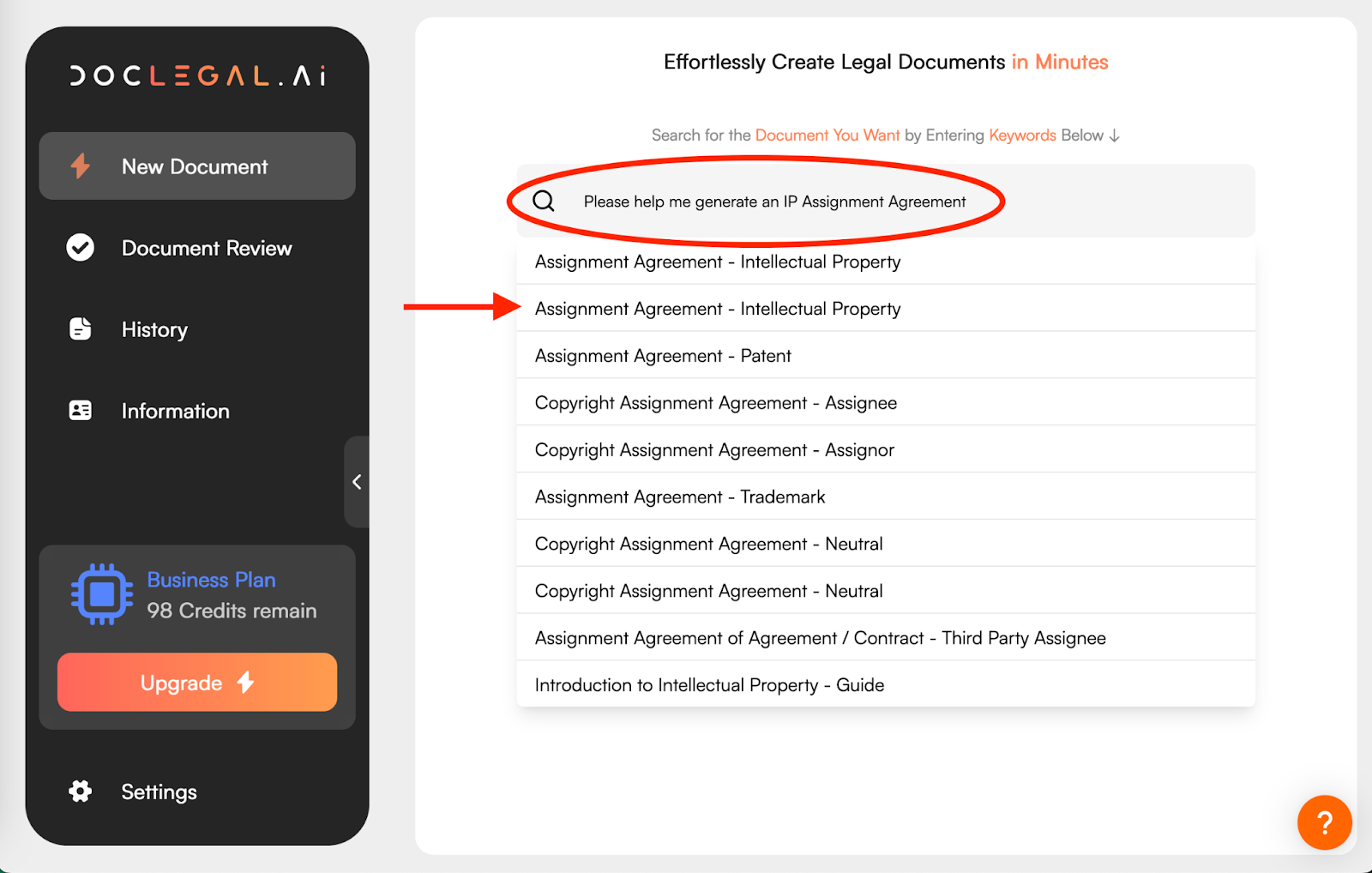
2. Describe the basic requirements of your agreement. You can edit the full document later on after seeing the draft agreement if you are unsure what to write at this stage.
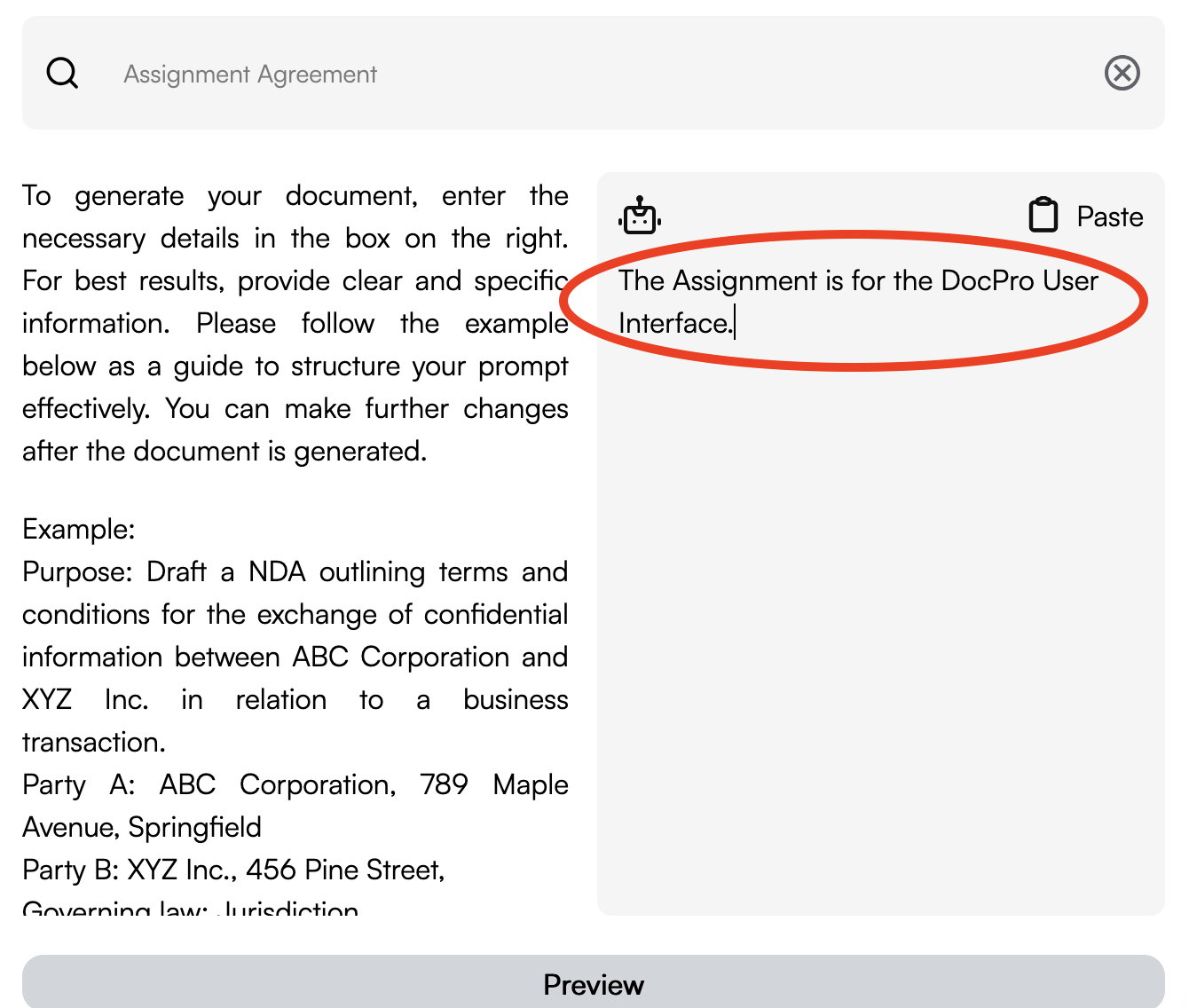
3. Click “Generate document” to generate the document draft, make further edits, and add more clauses.
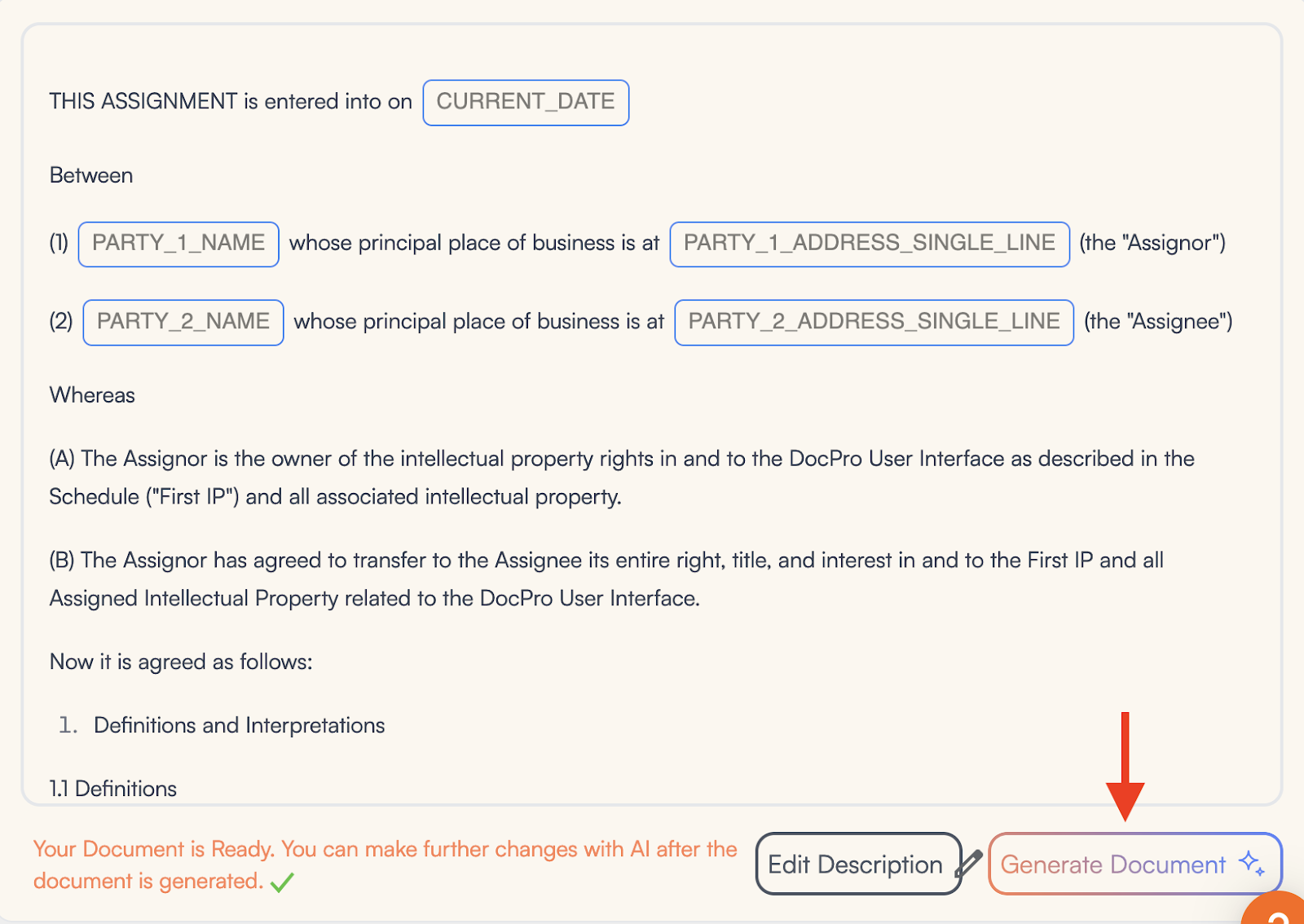
4. Use the “Document Review” chatbot to make further customisations to the document. When you are satisfied with the results, select “Proceed to Download” at the bottom right corner.
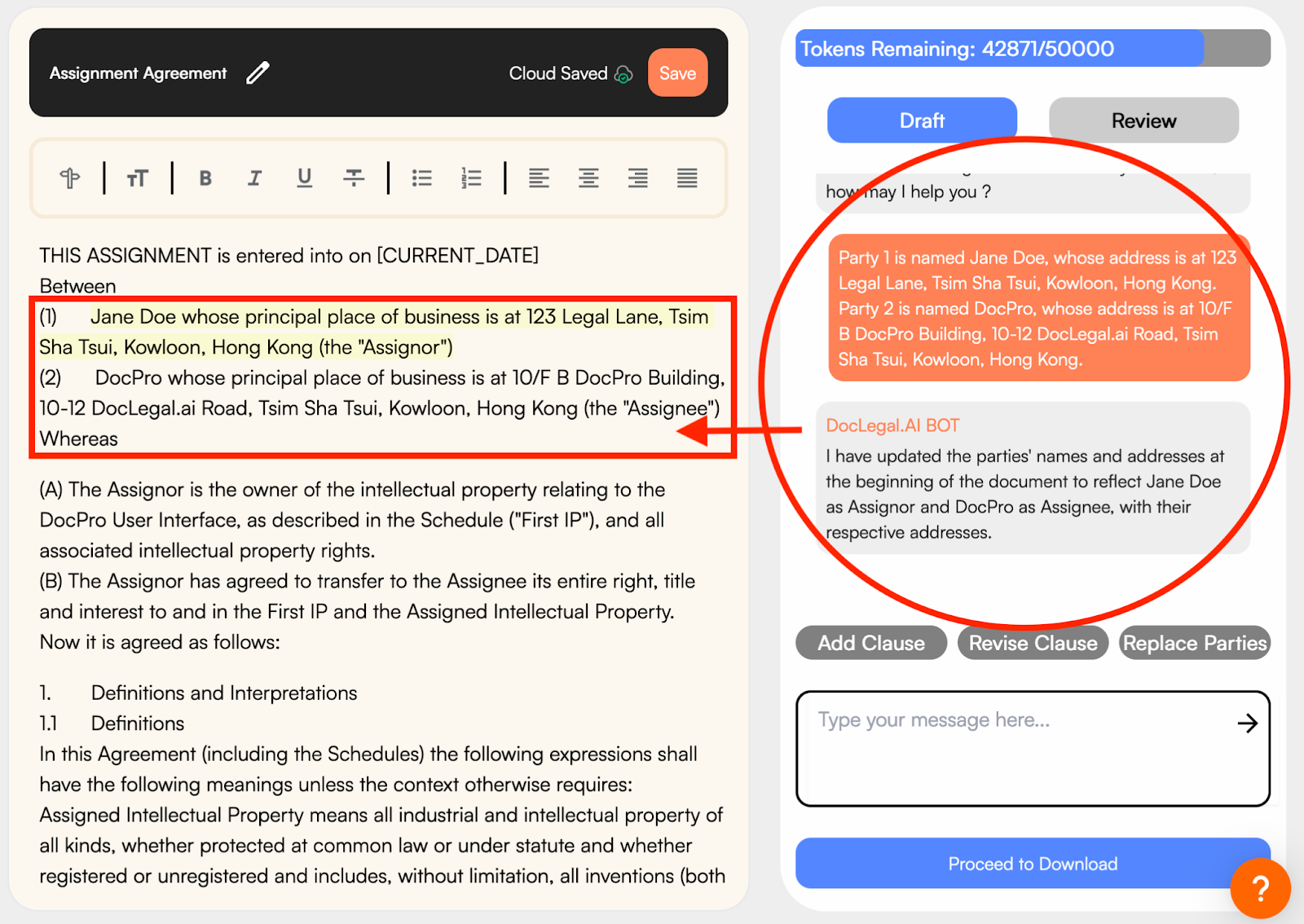
5. Select your preferred document format and download the finalised document! Tip: Downloading the document in Word or TXT file will allow you to make further manual edits later on. Alternatively, download it as a PDF if you are satisfied with the document and do not wish to make any further manual changes.
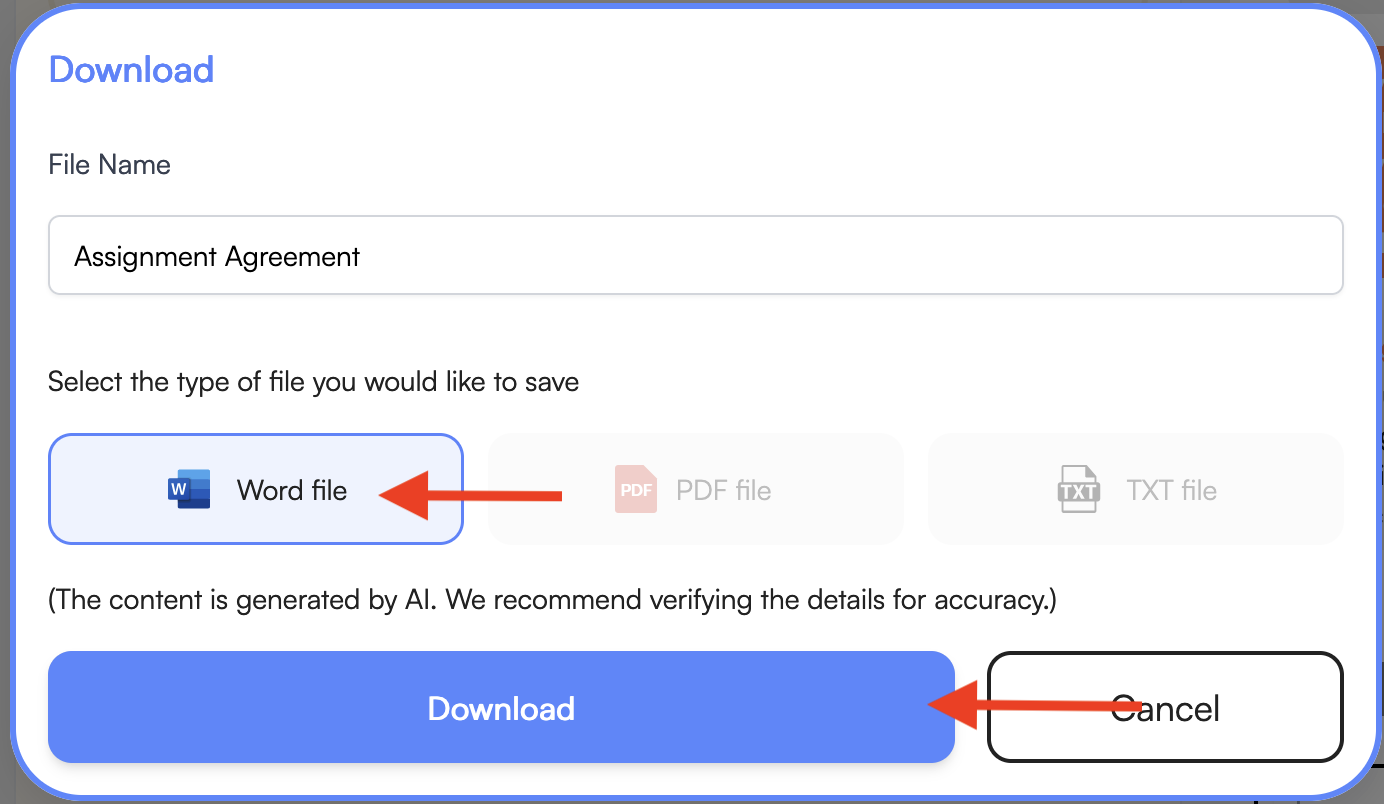
Frequently Asked Questions
- What does IP mean in simple terms?
IP is a type of property which is created through human intellect and is intangible (so while it is legally property, it is not something you can physically touch and pass around).
- What category of IP does my idea fall into?
Here are some common examples of IP categorisations:
- Trademark: Signs that distinguish the goods or services of one trader from those of others, such as a brand logo.
- Patent/design: Inventions, industrial products, or pharmaceutical drugs.
- Copyright: Books, software, plays, music, paintings, other artworks, broadcasts, or performances.
- Trade secret: “Secret” formulas (such as the Coca Cola formula), practices, manufacturing processes, other commercial methods, or compilations of information not generally known or reasonably ascertainable.
- How are IP’s protected?”
There are four categories of IP: trademarks, patents, copyright, and trade secrets. Trademarks and patents must be registered with an IP office in order to have effective legal protection (allowing you to bring legal actions against people who “steal” your idea), whereas copyright and trade secrets do not require registration. This means that even if a third party has not registered a copyrighted IP with the relevant office, they can still sue you for copyright infringement if you “steal” their idea.
- Why is IP protection important to startups and businesses?”
IP protections encourage creativity and innovation by allowing the creators to benefit from their hard work. If your startup invents a new product, you do not want your competitor to steal your ideas. Thankfully, (depending on the nature of your product) IP law may enable you to have a legal claim against your competitor if it steals your ideas. The same concept applies to your startup after an IP Assignment Agreement: if you purchase the full rights to an IP from a third party, you can now claim against anybody else who misuses that IP because you own it.
- What exclusive rights do copyright owners have?”
Copyright laws give copyright owners certain exclusive rights, including those to:
- Reproduce the work;
- Prepare derivative works based on the work;
- Distribute copies of the work to the public by sale or other transfer of ownership, or by rental, lease, or lending;
- Perform and display the work publicly; and
- Broadcast the work or include the work in a program.
Sample IP Assignment Agreement template
Below is a sample IP Assignment Agreement template. However, Doclegal.ai offers a more comprehensive, lawyer-approved IP Assignment Agreement template.
THIS ASSIGNMENT is entered into on [Date]
Between
(1) [Assignor’s name] whose principal place of business is at [Assignor’s address] (the "Assignor")
(2) [Assignee’s name] whose principal place of business is at [Assignee’s address] (the "Assignee")
Whereas
(A) The Assignor is the owner of the patent described in the Schedule ("First [Patent/Copyright/Trademark/Design]”) and the intellectual property associated with the First [Patent/Copyright/Trademark/Design].
(B) The Assignor has agreed to transfer to the Assignee its entire right, title and interest to and in the First [Patent/Copyright/Trademark/Design] and the Assigned Intellectual Property.
Now it is agreed as follows:
1. Definitions and Interpretations
1.1 Definitions
In this Agreement (including the Schedules) the following expressions shall have the following meanings unless the context otherwise requires:
Assigned Intellectual Property means all industrial and intellectual property of all kinds, whether protected at common law or under statute and whether registered or unregistered and includes, without limitation, all inventions (both patentable and unpatentable), confidential information, trademarks, designs, copyright, patents (registered and unregistered), plant breeder rights, trade secrets and know how, processes, improvements, modifications, derivations, semi-conductor or circuit layouts, and all other industrial and intellectual property rights associated with the First [Patent/Copyright/Trademark/Design] and in respect of the technology generally described in the schedule and any subject matter of the First [Patent/Copyright/Trademark/Design], all as existing at the date of this Assignment and including, without limitation:
(a) the exclusive right to prosecute the First [Patent/Copyright/Trademark/Design];
(b) it to apply for and prosecute anywhere in the world;
(c) any patent or intellectual property rights, registration or protection in respect of the technology in the schedule or the subject matter of the First [Patent/Copyright/Trademark/Design];
(d) the exclusive right to protect by proceedings anywhere in the world the intellectual property rights In respect of the intellectual property described in the Schedule or the subject of the First [Patent/Copyright/Trademark/Design];
(e) the exclusive benefit of and the exclusive right to take or to refrain from taking action anywhere in the world against third parties on account of any claim for infringement of the First [Patent/Copyright/Trademark/Design] or the Assigned Intellectual Property, whenever and wherever occurring, and
(f) the exclusive right to assign or license or otherwise dispose of all or any part of the property described above to any assignee or licensee anywhere in the world,
in each case for the holder's sole benefit without obligation to account to any other person,
Business Day means a day on which trading banks are open for business in [Jurisdiction].
1.2 Interpretation
In this Agreement, unless the context otherwise requires:
(a) singular includes plural and plural includes singular;
(b) words of one gender include any gender;
(c) reference to legislation includes any amendment to it, any legislation substituted for it and any statutory instruments issued under it and in force;
(d) reference to a person includes a corporation, a firm and any other entity;
(e) reference to a party includes that party’s personal representatives, successors and assigns; and
(f) headings do not affect interpretation.
2. Assignment
2.1 The Assignor irrevocably and absolutely assign to the Assignee, its entire rights, title and interests to and in the First [Patent/Copyright/Trademark/Design] and the Assigned Intellectual Property Rights free from all mortgages, charges and other security interests.
2.2 The assignment takes effect as at the date of this Assignment.
3. Consideration
In consideration of the assignments of the First [Patent/Copyright/Trademark/Design] and the Assigned Intellectual Property under this Assignment, which will be satisfied by:
the Assignee will pay the sum of [Currency] [Amount] (receipt of which the Assignor hereby acknowledges).
4. Warranties
The Assignor warrants to the Assignee that:
(a) it has the power to enter into and perform its obligations under this Assignment;
(b) it has obtained all necessary approvals and consents to authorise its entry into and performance of the Assignment;
(c) the rights in the First [Patent/Copyright/Trademark/Design] and the Assigned Intellectual Property assigned under clause 2 are assigned free from all mortgages, charges and other security interests;
(d) its obligations under this Assignment are valid and binding obligations in accordance with the terms;
(e) it has not assigned, licensed or otherwise disposed of all of or any interest in any of the First [Patent/Copyright/Trademark/Design] or the Assigned Intellectual Property to any person other than the Assignee; and
(f) as far as they are aware, there has not been any:
(1) infringement by any person of the First [Patent/Copyright/Trademark/Design] and the Assigned Intellectual Property;
(2) any misuse or unauthorised disclosure of the confidential information relating to the First [Patent/Copyright/Trademark/Design] and the Assigned Intellectual Property;
(3) any other act which affects the validity or enforceability of First [Patent/Copyright/Trademark/Design] and the Assigned Intellectual Property.
5. Further Assurances
The Assignor agrees to perform (or procure the performance of) all further acts and things, and execute and deliver (or procure the execution and delivery of) all such further documents as may be required by law or as may be necessary or reasonably desirable to implement and/or give effect to this Assignment, and as the Assignee may, from time to time, reasonably request for the purpose of implementing this Assignment.
6. Costs and Duties
6.1 Each party must pay their own costs in respect of the negotiation, preparation and execution of this Assignment and any document contemplated by this Assignment.
6.2 The Assignee must pay any stamp duty payable in respect of this Assignment.
7. Governing Law
7.1 A person who is not a party to this Agreement shall have no right to enforce any of its terms.
7.2 This Assignment and the relationship between the parties shall be governed by, and interpreted in accordance with, laws of [Jurisdiction].
8. Dispute Resolution
8.1 Each party irrevocably and unconditionally submits to the exclusive jurisdiction of the courts of [Jurisdiction] (and any court of appeal) and waives any right to object to an action being brought in those courts, including on the basis of an inconvenient forum or those courts not having jurisdiction.
9. Counterparts
9.1 This Assignment may be executed in any number of counterparts and by the parties to it on separate counterparts, each of which is an original but all of which together constitute one and the same instrument.
10. No Rights Under Contracts (Rights of Third Parties) Ordinance
10.1 A person who is not a party to the Agreement shall have no right under the Contracts (Rights of Third Parties) Ordinance to enforce any of its terms.
As witness this Agreement has been signed by the duly authorised representatives of the parties the day and year above written.
SIGNED by
)
for and on behalf of [Assignor’s name]
)
__________________
SIGNED by
)
for and on behalf of [Assignee’s name]
)
__________________
SCHEDULE
Description of First [Patent/Copyright/Trademark/Design]
[Description / diagrams of the IP]

.jpg)



.jpg)

.jpg)